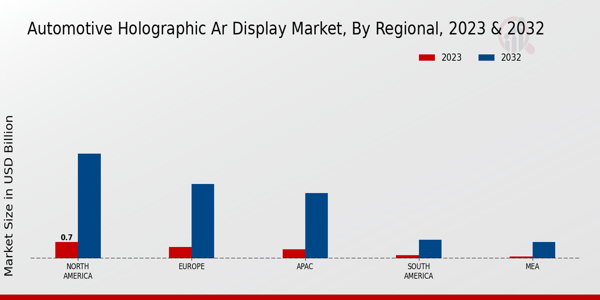Market Growth Projections
The Global Automotive Holographic AR Display Market Industry is poised for remarkable growth, with projections indicating a rise from 2.78 USD Billion in 2024 to 27.5 USD Billion by 2035. This growth trajectory reflects a compound annual growth rate (CAGR) of 23.18% from 2025 to 2035, highlighting the increasing demand for advanced display technologies in the automotive sector. The market's expansion is driven by various factors, including technological advancements, consumer preferences for safety features, and regulatory support for innovative automotive technologies. As the industry evolves, the integration of holographic displays is likely to become a standard feature in modern vehicles.
Technological Advancements
The Global Automotive Holographic AR Display Market Industry is experiencing rapid technological advancements, particularly in display technologies and augmented reality applications. Innovations in holographic displays, such as improved resolution and brightness, enhance user experience and safety. For instance, companies are integrating AR displays with advanced driver-assistance systems (ADAS), providing real-time navigation and hazard alerts. This integration not only improves driving safety but also elevates the overall driving experience. As a result, the market is projected to grow from 2.78 USD Billion in 2024 to an estimated 27.5 USD Billion by 2035, indicating a robust demand for these technologies.
Growing Adoption of Electric Vehicles
The growing adoption of electric vehicles (EVs) is influencing the Global Automotive Holographic AR Display Market Industry. As EV manufacturers strive to differentiate their products, many are integrating advanced technologies, including holographic displays, to enhance user experience and functionality. Holographic AR displays can provide essential information about battery status, charging locations, and energy consumption, thereby improving the overall driving experience. This trend aligns with the increasing focus on sustainability and innovation in the automotive sector, suggesting that the market for holographic displays will expand as more consumers opt for electric vehicles.
Rising Investment in Automotive Technology
Rising investment in automotive technology is significantly impacting the Global Automotive Holographic AR Display Market Industry. As automotive companies allocate substantial resources towards research and development, the focus on integrating cutting-edge technologies, such as holographic displays, intensifies. This investment trend is driven by the need to remain competitive in a rapidly evolving market. With a projected compound annual growth rate (CAGR) of 23.18% from 2025 to 2035, the market is expected to witness substantial growth as manufacturers innovate and enhance their product offerings to meet consumer expectations.
Increased Consumer Demand for Enhanced Safety Features
Consumer demand for enhanced safety features in vehicles is a significant driver for the Global Automotive Holographic AR Display Market Industry. As awareness of road safety increases, consumers are seeking vehicles equipped with advanced technologies that provide real-time information and alerts. Holographic AR displays can project critical data, such as speed and navigation, directly onto the windshield, minimizing distractions and allowing drivers to maintain focus on the road. This shift towards safety-oriented features is likely to propel market growth, as manufacturers respond to consumer preferences by incorporating holographic displays into their vehicle designs.
Regulatory Support for Advanced Driver Assistance Systems
Regulatory support for advanced driver assistance systems (ADAS) is a pivotal factor driving the Global Automotive Holographic AR Display Market Industry. Governments worldwide are implementing regulations that encourage the adoption of safety technologies in vehicles. Holographic AR displays, which can enhance ADAS by providing real-time data visualization, are likely to benefit from these regulations. As manufacturers comply with safety standards, the integration of holographic displays into vehicles may become more prevalent, further propelling market growth. This regulatory environment creates a favorable landscape for the development and deployment of innovative display technologies.
























